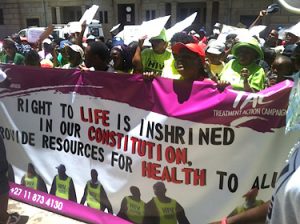
Treatment Action Campaign right to health march
Inequity kills — by one measure, more than one in three of us. And this unconscionable toll hasn’t been getting much better.
That was the finding from calculations by Juan Garay of the European Commission several years back, explained in his new book available for free viewing, Health Equity: The Key for Transformational Change (p. 33-35). Essentially, if low- and middle-income countries were to have the same under-five and adult (ages 15-60) mortality rates as the average for high-income countries, they would have had some 20 million fewer deaths every year. That is, every year 20 million people are dying because of where they were born, in a low- or middle-income country rather than a wealthy country. And on top of this, not part of the calculations, would be residents of low- or middle-income countries who live past 60 but still might have lived longer in wealthier countries, and the many who die in wealthy countries because of their own inequities.
This level of excess, inequality-related mortality has been quite stable despite overall global health improvements, with 18.2 million in 1970, a peak of 20.9 million in 2000, and still near the peak in 2010, with 20.3 million such deaths (p. 35).
One might argue that at least in present conditions, the standard of high-income countries is, at least as a practical matter, too high. As Professor Garay asks, if the higher life expectancy is linked to above average wealth, but there are not enough resources at present to enable all countries to achieve this level of wealth, how can we expect these standards to be replicated in every country? And the economic development in the world’s wealthy countries has had environmental effects, above all on our climate, that are unsustainable for these countries, much less a model of growth that the world can follow.
Because of these questions of sustainability and universal feasibility, should we ask instead, or as well, how many inequity-related deaths could be avoided consistent with global resources and environmentally sustainable practices? This Professor Garay proceeds to do – and discovers that the answer is not all that different.
The book’s analysis turns to “healthy countries” – ones with life expectancies above the global average – that could serve as global models today. These are countries with gross domestic products below average, avoiding the possibility that the world’s economic resources are simply too few for their levels of health to be achieved by all. And they all have a low carbon footprint (an average of 2.5 metric tons per person in 2000-2010, compared to the present global average of 6 tons per person), indicative of environmental sustainability.
Professor Garay identifies 14 such countries: Albania, Armenia, Belize, Colombia, Costa Rica, Cuba, Georgia, Grenada, Paraguay, St. Lucia, St. Vincent and the Grenadines, Sri Lanka, Tonga, and Vietnam. In 2012, their average life expectancy was 75, compared to a global average of 71 years (p. 40).
Using these countries (concedely, mostly low population nations, raising issues of replicability) as the benchmark, the number of deaths stemming from global health inequities remains huge and persistent – and not distant from when high-income countries serve as the standard. Professor Garay’s methodology differs slightly from the previous estimate. Here, the calculation (p. 45-49) compares average mortality rates disaggregated by age and sex of these 14 countries to those of every country in the world. The excess deaths – based on the difference between the mortality rates in the 14 countries and each country with worse mortality rates – are then added up, with the total being the total number of deaths attributed to global health inequity.
Again, the number has varied little over the years. From 1965-1970 to 1990-1995, the number of these deaths ranged from just below 16 million to about 17.6 million, before peaking at 18.6 million in 1995-2000, and then falling to 16.8 million (2005-2010).
The persistence of these health inequalities – and the recognition that the vast majority of these deaths could be prevented – behooves us to find a new way of responding to them. For all the progress the world has made on health over the past decades, current approaches are not enough.
This need for a new way of doing things is one reason to support a Framework Convention on Global Health (FCGH), the proposed global health treaty based in the right to health and aimed at national and global health equity. Mobilization towards the FCGH is accelerating, with an effort to secure, as part of a resolution at this year’s World Health Assembly, a request to the WHO Director-General to establish a working group that includes strong civil society participation to examine and report on the potential benefits, principles, and parameters of the FCGH – launching a formal process towards the FCGH. I encourage you to sign this petition to the WHO Executive Board, meeting in late January, to support this call. And for those of you representing organizations in Africa, we have this sign-on letter, with the same message.
These global health inequities are not inevitable. There is no single solution. But the FCGH stands to be a particular powerful tool to establish pathways and accountability towards ending this most lethal of injustices. With so many millions dying every year due to health inequities, there is no time to lose in doing everything in our power to end this wrong – including negotiating, adopting, ratifying, and implementing the FCGH.



